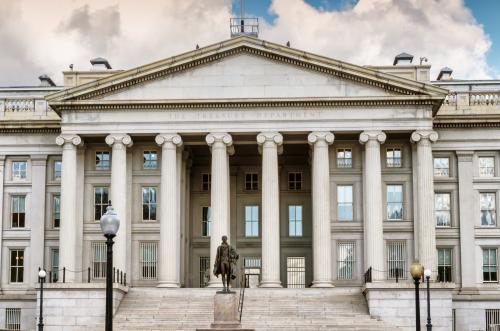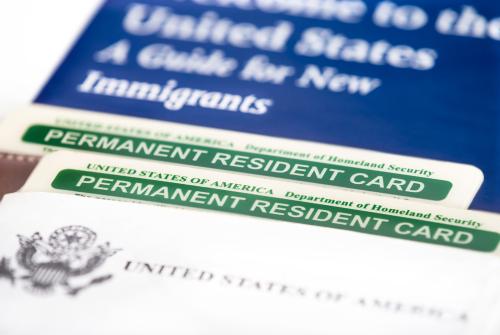This post was updated on February 26, March 24 and 29, and April 7, to reflect the latest developments in Congress.
With the Senate evenly divided between Democrats and Republicans, 50 each, giving Vice President Kamala Harris the tie-breaking vote, there is a lot of attention to a legislative process for getting tax and spending bills through the Senate known as reconciliation. Here’s what it is and how it works.
When and why does Congress use reconciliation?
Reconciliation is, essentially, a way for Congress to enact legislation on taxes, spending, and the debt limit with only a majority (51 votes, or 50 if the vice president breaks a tie) in the Senate, avoiding the threat of a filibuster, which requires 60 votes to overcome. Because Democrats have 50 seats in the Senate—plus a Democratic vice president—reconciliation is a way to get a tax-and-spending bill to the president’s desk even if all 50 Republicans oppose it.
Since its first use in 1980, reconciliation has been used to enact 22 bills as of April 2021 (four others were passed but vetoed by the president), including such significant pieces of legislation as major deficit reduction bills in the 1980s and 1990s, welfare reform in 1996, the Bush tax cuts in 2001 and 2003, the Trump tax cuts in 2017, and the American Rescue Plan under Joe Biden. It also played a big role in shaping the Affordable Care Act in 2010. Republicans tried and failed to use reconciliation to repeal large parts of the Affordable Care Act in 2016 and 2017. President Obama vetoed the 2016 attempt; the “no” votes of three Republican senators blocked the 2017 effort.
How does the reconciliation process work?
Congress is supposed to pass a blueprint for tax and spending bills called a budget resolution every year, though it doesn’t always do so. A budget resolution requires approval of a majority vote in the House and in the Senate (not 60 votes). The president plays no role. The Congressional Budget Act permits the use of the reconciliation process only if the House and Senate first agree on a budget resolution that includes “reconciliation instructions,” that is, dollar targets for committees to raise or lower spending or revenues for a given fiscal year or a period of years. Such resolutions do not detail what specific legislative changes a committee should adopt to meet its targets. After the committees finish their work, the budget committees in the House and Senate assemble the recommendations into a single omnibus bill—the reconciliation bill. In the House, as with any legislation, the majority rules. In the Senate, a reconciliation bill requires only a majority. Once both houses agree on this omnibus bill, it goes to the president to sign or veto.
How many reconciliation bills can Congress consider in calendar year 2021?
Under usual practice, two: one for fiscal year 2021 (which ends September 30, 2021) and another for fiscal year 2022 (which ends September 30, 2022). Congress doesn’t pass a budget resolution every year, and it didn’t pass one for fiscal year 2021 in the last Congress, largely because there was little chance that the Republican majority in the Senate could come to agreement with the Democratic majority in the House.
With Democrats in control of both the House and Senate, both houses moved quickly in early February to pass a budget resolution for fiscal year 2021. (Vice President Harris broke a tie in the Senate.) The resolution cleared the path for a reconciliation bill that enacted President Biden’s $1.9-trillion American Rescue Plan. It extended pandemic-related unemployment benefits, sent $1,400 per person checks to most households, beefed up the public health system, sent aid to state and local governments, and expanded the Child Tax Credit. The bill passed the Senate 50-49 (with one Republican not voting). Democrats may craft a second budget resolution (technically for fiscal year 2022) and a second reconciliation bill later this year, one that would include longer-run elements of Biden’s “Build Back Better” program, including investments in infrastructure and perhaps tax increases.
In April 2021, Senate Parliamentarian Elizabeth MacDonough agreed with Senate Democrats that under the previously obscure Section 304 of the Congressional Budget Act, the Senate can repeatedly revise the budget resolution for the current fiscal year to create additional reconciliation bills. Democrats may invoke that provision to avoid a filibuster on President Biden’s infrastructure and corporate-tax-increase bill, the American Jobs Act, and get some version through the Senate with 50 votes.
Can a reconciliation bill increase the budget deficit?
Yes. Although the reconciliation process originally was viewed as a way to reduce budget deficits by cutting projected spending and raising revenues, it has been used to expedite passage of tax cuts that increase budget deficits. If reconciliation is used this year to enact some version of President Biden’s COVID relief bill, it will increase budget deficits.
(Here’s a bit of history, provided by budget mavens David Reich and Richard Kogan at the Center on Budget and Policy Priorities: In 2007, when Democrats took control of the House and Senate, both chambers adopted rules designed to prohibit use of reconciliation for measures that increase deficits. When Republicans took the House in 2011, they replaced the House rule with one that placed no restrictions on tax cuts that increase deficits but prohibited reconciliation bills that would produce a net increase in spending on Medicare, Medicaid, food stamps, farm programs, or other entitlements, often called “mandatory” spending because they don’t involve annual congressional appropriations. That rule was repealed at the beginning of the new Congress in 2021. The Senate rule against deficit-increasing reconciliation bills was repealed in 2015.)
Although a reconciliation bill can increase near-term budget deficits, there are a couple of wrinkles. A Senate rule says that a reconciliation bill cannot, under congressional scoring, increase the deficit beyond the period specified in the resolution, usually ten years. That’s why the reconciliation bills that enacted the Bush and Trump tax cuts said that some of the tax cuts expire before the tenth year.
A separate law, the Statutory PAYGO Act of 2010, establishes a scorecard to keep track of the cost of any new mandatory spending or tax changes. A reconciliation bill, such as the one Congress may consider for Biden’s COVID relief package, would create costs on the PAYGO scorecard for the next five years. Under the law, 15 days after a session ends—say, January 15, 2022—the law requires an across-the-board budget cut to all mandatory programs (except those specifically exempt, which include Social Security, veterans’ benefits, Medicaid, and other major means-tested entitlements) to offset one year’s worth of costs on the scorecard for fiscal year 2022. So if a bill costs $2 trillion over five years, the average annual impact—$400 billion, in this example—would show up on the FY2022 scorecard to be squeezed out of Medicare, farm benefits, etc. Congress cannot waive the provisions of the PAYGO Act in a reconciliation bill, but it usually does waive them in some subsequent piece of legislation, one which could require a 60-vote majority in the Senate.
In addition, press reports suggest that Senate Majority Leader Chuck Schumer is considering invoking an obscure provision of the Congressional Budget Act that would essentially re-use the fiscal year 2021 budget resolution to allow for a majority in the Senate to approve Biden’s big infrastructure package. Never used before, Section 304 says Congress “may adopt a concurrent resolution on the budget which revises or reaffirms the concurrent resolution on the budget for such fiscal year most recently agreed to.”
What are the major limits on the use of reconciliation?
One feature of the reconciliation process is the Byrd Rule in the Senate, named for its chief proponent, the late Sen. Robert Byrd (D-W.Va.). Designed to prevent “extraneous” provisions from benefitting from the expedited reconciliation process, the Byrd Rule gives senators the right to object to any provision that doesn’t change the level of spending or revenues, or one for which the change in spending or revenues is “merely incidental.” Initial interpretations of the Byrd Rule are made by the Senate parliamentarian, a non-partisan position.
The Byrd Rule binds only if a senator raises what’s known as a “point of order.” If one does, it takes the consent of 60 senators to overturn a point of order. Items that are stripped from a reconciliation bill because of this rule are known as “Byrd droppings”—and often are dropped before a bill comes to the floor. The process of deleting those provisions is known as a “Byrd bath.”
Among other things, the Byrd Rule also says that changes to Social Security benefits or Social Security payroll taxes cannot be considered as part of a reconciliation bill.
Many substantive provisions have become Byrd droppings over the years, but sometimes the rule becomes more of a way for the minority to annoy the majority. During consideration of the 2017 tax cut bill under reconciliation, for instance, Sen. Bernie Sanders (D-Vt.) objected that a section that gave the law the name “Tax Cuts and Jobs Act” was “extraneous” under the Byrd Rule. As a result, that name had to be dropped, and the statute has no plain English title.
What is and isn’t allowed under the Byrd Rule is not always black and white. The Temporary Assistance for Needy Families (TANF) program was created in a reconciliation bill in 1996 because the rule allows provisions that are not budgetary if they are “terms and conditions” of provisions that are budgetary. The winning argument was that the provision created block grants to states—clearly budgetary—and all the rest constituted “terms and conditions.” The Senate Parliamentarian ruled in late February that the Byrd Rule precludes including in a reconciliation bill an increase in the minimum wage, disappointing those Democrats who had hoped to include a provision increasing the minimum wage to $15 an hour so it would need only 50 votes to pass the Senate.






Commentary
What is reconciliation in Congress?
February 5, 2021